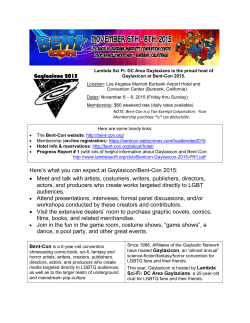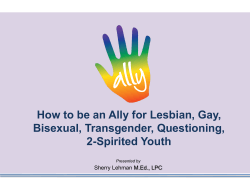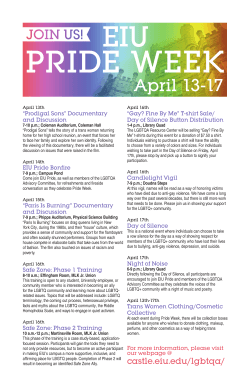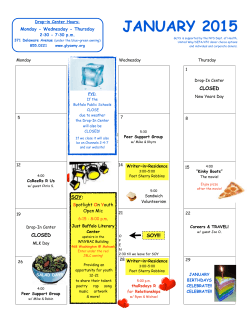
Super Allies: How to Support LGBTQ Youth
Super Allies: How to Support LGBTQ Youth Jenn Jevertson, MS & LuzMarina Serrano Santa Fe Mountain Center’s NM Gay Straight Alliance Overview • Understanding Terms • Impact of Language • Challenges & Risk Factors • Protective Factors • How to be a “Super Ally” Gender & Sexuality *Please note that the creator of this visual co-opted this idea from another existing source. Gender & Sexuality Circular Spectrum both Birth Sex Gender Identity Gender Expression male female Sexual Orientation neither Terms LGBTQ (or LGBTQQIFGOP…..) Sexual Orientation - Gay, Lesbian, Bisexual, Queer, Polysexual, Pansexual/Omnisexual, Asexual Gender Identity - Male, Female, Transgender, Transexual, Intersex, Genderqueer, Gender Non-Conforming Other terms - Two Spirit (2S), Fluid 1. Best Friend 5. Hopes & Aspirations 2. Family Member YOU 4. Job/ Career 3. Community Group Risk Factors • Bullying • Mental Health • Suicide • Risky Behavior • School Climate (attendance, grades, slurs) • School Pushout • Documentation status Risk Factors: School Climate Risk Factors: Derogatory Language Risk Factors: Bullying Behavior High 2013 High School NM Youth Risk and Resiliency Survey: Did not go to school because they felt unsafe at school or on their way to or from school: -Straight = 4.9% Were electronically bullied: - LGB = 14.9% -Straight = 10.9% - LGB = 27.6% Were bullied on school property: LGB = 32.3% -Straight = 16.2% - Risk Factors: Derogatory Language NMGSAN’s 2013 School Climate Survey: 91% hear anti-LGBTQ slurs; 48% hear several times a day 39% hear anti-LGBTQ slurs made by school staff How often do school staff step in when they hear anti-LGBTQ slurs? 17% “never” 35% “rarely” 28% “sometimes” Risk Factors: Risk Behaviors • Risk behaviors (e.g. drugs, alcohol, etc) among gay or lesbian students was a median of 64% higher than heterosexual students. Risk Factors: School Pushout • School Pushout = school policies, practices and procedures that make it more likely for students to leave school instead of finish it. • These include “zero tolerance”, harsh discipline, unsafe schools and schools with lots of police but little money or resources. • Disproportionately impact LGBTQ students, students of color, immigrant students, and students with disabilities. • Students who get pushed out are more likely to end up in jail or juvenile detention. 3x LGBT youth are more likely to experience criminal justice and school sanctions than straight students. Risk Factors: Suicide Risk Factors: Homelessness • 20-40% of all homeless youth identify as lesbian, gay, bisexual, and/or transgender. Risk Factors: Documentation Status UNDOCUQUEER = undocumented + queer 1.8 million undocumented youth (as of 2012) risk of separation of families restricted access to some resources Protective Factors • GSA Clubs • Safe Zone Programs • Supportive Adult Allies Protective Factors: Gay Straight Alliance Clubs (GSAs) • hear fewer homophobic remarks • greater sense of school connectedness • less likely to report feeling unsafe • experience less victimization • school personnel intervene more often when hearing homophobic remarks Protective Factors: Safe Zone/Safe Space Programs • A program often adopted by school/district that involves trainings for volunteers and education/awareness • Originated in the 1990’s on college campus to promote safety and inclusion of LGBTQ students • Now adopted by elementary, middle, high schools and often includes other categories of discrimination/bias Protective Factors: Supportive Adult Allies • LGBTQ students feel safer • LGBTQ students perform better academically - higher grade point averages - better attendance - more likely to say they plan to pursue post-secondary school 5 Ways to be an Ally 1. 2. Intervene when you see bullying or harassment of any type, especially towards LGBTQ youth. Stop all derogatory language, especially directly or indirectly towards LGBTQ youth. 3. Use inclusive language; don’t assume – Use “significant other” or “person you’re interested in” vs. “boyfriend” or “girlfriend.” 4. Support the Gay Straight Alliance (GSA) in your school. 5. Be a visibly supportive educator/staff. (Join the “Safe Zone” Program and/or put up a “Safe Zone” sign.) How do I be more LGBTQ inclusive? 1. 2. Role model positive and inclusive attitudes towards LGBTQ people. Celebrate GLSEN Days of Action (LGBTQ History Month (Oct), National Day of Silence, No Name Calling Week, Coming Out Day, etc). 3. Learn about and share examples of historical LGBTQ people and events. 4. Include LGBTQ relationships in health and sexuality education. Contact Us Santa Fe Mountain Center’s NM GSA Network www.santafemc.org/nmgsan LuzMarina Serrano Program Coordinator 505-983-6158 x30 luzmarina@santafemc.org
© Copyright 2025





















